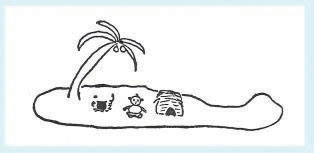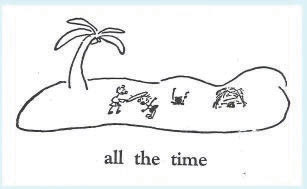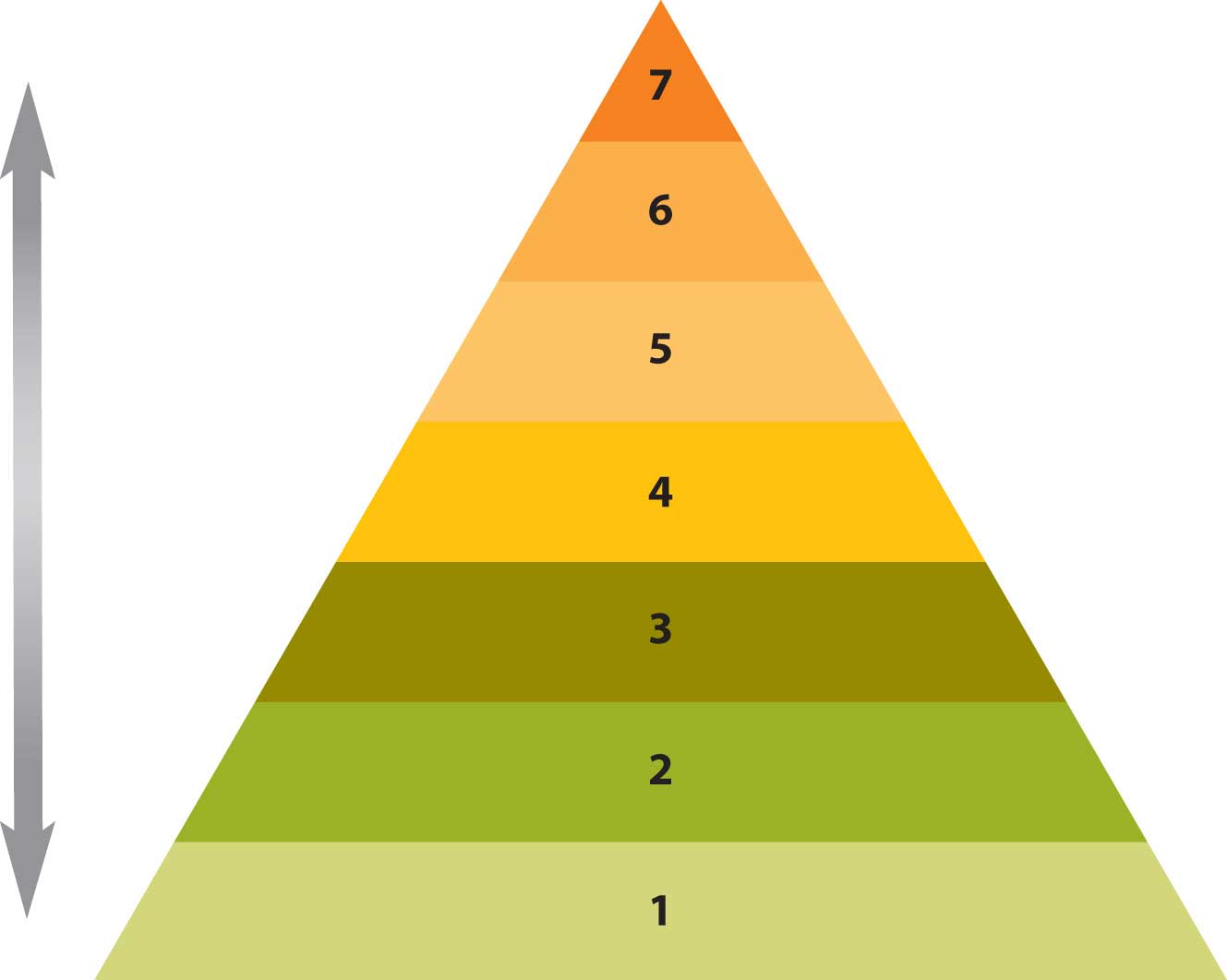This is “Why Communicate in Groups?”, section 2.3 from the book An Introduction to Group Communication (v. 0.0). For details on it (including licensing), click here.
For more information on the source of this book, or why it is available for free, please see the project's home page. You can browse or download additional books there. To download a .zip file containing this book to use offline, simply click here.
2.3 Why Communicate in Groups?
PLEASE NOTE: This book is currently in draft form; material is not final.
Learning Objective
- Understand the role of interpersonal needs in group communication.
“I love mankind. It’s people I can’t stand.”
Charles M. Schulz (through Charlie Brown)
“Communication is a continual balancing act, juggling the conflicting needs for intimacy and independence.”
Deborah Tannen

Munro Leaf wrote and illustrated a classic children’s book in 1936 called Manners Can Be Fun. Here are the drawings and text from its first few pages:

If you lived all by yourself out on a desert island, others would not care whether you had good manners or not. It wouldn’t bother them. But if someone else lived there with you, you would both have to learn to get along together pleasantly.

If you did not, you would probably quarrel and fight all the time, or—–

stay apart and be lonesome because you could not have a good time together. Neither would be much fun.
Although Leaf’s drawings and text are simple and plain, they convey important truths about human beings: we need to get along with other people, and to get along we need to communicate in groups.
If we ask ourselves, then, “What’s the point of communicating in groups instead of just sitting at home or in a workplace alone?” we’ll conclude that our group interactions and relationships help us meet basic human needs. We may also recognize that not all our needs are met by any one person, job, experience, or context; instead, we need to diversify our communication interactions in order to meet our needs.McLean, S. (2010). Business Communication for Success. Irvington, NY: Flat World Knowledge.
At first, you may be skeptical of the idea that we communicate to meet our basic needs. Let’s consider two theories on the subject, however, and see how well they predict, describe, and anticipate our tendency to interact.
Abraham Maslow’s Hierarchy of NeedsA model characterizing human needs from the most basic (physical) to the most complex (aesthetic appreciation)., represented in Figure 2.1 may be familiar to you.Maslow, A. (1970). Motivation and Personality (2nd ed.). New York, NY: Harper & Row. We need the resources listed in level one (e.g., air, food, and water) to survive. If we have met those basic needs, we move to level two: safety. A job may represent this level of safety at its most basic level. Regardless of how much satisfaction you may receive from a job well done, a paycheck ultimately represents meeting basic needs for many.
If we feel safe and secure, we are more likely to seek the companionship of others. Human beings tend to form groups naturally, and if basic needs are met, love and belonging occur in level three. Perhaps you’ve been new to a class, or a club, or at work and didn’t understand the first thing about what was going on. Conflict may have been part of that experience, but you were probably still eager to interact with the other people in the group rather than staying by yourself like the miserable stick figure in Leaf’s final drawing of the desert island.
As you came to know what was what and who was who, you learned how to negotiate the landscape and avoid landmines. Your self-esteem (level four) improved as you perceived that you belonged as part of the group.
Over time, you may have learned your job tasks and the strategies for succeeding in your class, your club, or your job. Perhaps you even came to be known as a reliable resource for others, as someone who would know how to respond helpfully if someone came to you with a problem. People may eventually have looked up to you within your role and have been impressed with your ability to make a difference. Maslow called this “self-actualization” (level five) and discussed how people come to perceive a sense of control or empowerment over their context and environment.
Beyond self-actualization, Maslow recognized our innate need to know (level six) that drives us to grow and learn, explore our environment, or engage in new experiences. We come to appreciate a sense of self that extends beyond our immediate experiences, beyond the function, and into the community and the representational. We can take in beauty for its own sake, and value aesthetics (level seven) that we previously ignored or had little time to consider.
Figure 2.1

Maslow’s Hierarchy of Needs
Maslow’s theory is individualistic, focusing primarily on how one person at a time may meet his or her basic needs. The theory has been criticized in light of the fact that many cultures are not centered on the individual. It’s also been pointed out that even people whose physical resources are severely limited can enjoy rich interpersonal relationships and experience cultural, intellectual, and social treasures. Nevertheless, Maslow’s hierarchy serves as a good place from which to begin our discussion about group communication.
What do we need from our environment? Why do we communicate in groups? The answers to both questions are often related.
William Schutz’s Interpersonal Needs offered an alternate version of human interaction.Schutz, W. (1966). The Interpersonal Underworld. Palo Alto, CA: Science and Behavior Books. Like Maslow, he considered the universal aspects of our needs, but he contended that they operate within a range or continuum for each person.McLean, S. (2010). Business Communication for Success. Irvington, NY: Flat World Knowledge. According to Schutz, the need for affection, or appreciation, is basic to all humans. We all need to be recognized and feel like we belong, but some people need more interaction with groups than others. Schutz describes underpersonalsAccording to William Schutz, someone who prefers limited interaction with others. as people who seek limited interaction. On the opposite end of the spectrum, you may know people in school or at work who continually seek attention and affirmation. Schutz refers to these people as overpersonalsAccording to William Schutz, someone who continually seeks attention and affirmation.. The individual who strikes a healthy balance between meeting needs through solitary action and group interaction is referred to as a personal individual.
Humans also have a need for control, or the ability to influence people and events. But that need may vary according to the context, environment, and sense of security. If you act primarily autonomously to plan and organize your affairs as part of a group, Schutz would describe your efforts to control your situation as autocraticAccording to William Schutz, an individual who acts autonomously to plan and organize his or her affairs as part of a group., or self-directed. AbdicratsAccording to William Schutz, an individual who relinquishes personal responsibility and instead relies on others for a sense of control., on the other hand, are people who according to Schutz shift the burden of responsibility from themselves to others and rely upon others for a sense of control. DemocratsAccording to William Schutz, an individual who gathers and shares information in a balanced fashion to acquire a sense of control as part of a group., finally, balance individual and group and are apt to gather and share information on the road to group progress.
Finally, Schutz echoed Maslow in his assertion that belonging is a basic interpersonal need, but he noted that it exists within a range or continuum and that some people need more and others less. UndersocialsAccording to William Schutz, an individual who avoids taking a central role or engaging in major interactions within a group. may be less likely to seek interaction, may prefer smaller groups, and will generally not be found on center stage. OversocialsAccording to William Schutz, an individual who craves attention and is intensely motivated to seek belonging as part of a group., by contrast, crave attention and are highly motivated to seek belonging. A socialAccording to William Schutz, an individual who seeks a sense of belonging in a group by striking a balance between involvement and withdrawal. person is one who strikes a healthy balance between being withdrawn and being the constant center of attention.
Schutz described these three interpersonal needsAnother model characterizing human needs, including affection, control, and belonging. of affection, control, and belonging as interdependent and variable. In one context, an individual may have a high need for control, while in others he or she may not perceive the same level of motivation or compulsion to meet that need. Maslow and Schutz offer us two related versions of interpersonal needs that begin to address the central question: why communicate in groups?
We communicate with each other to meet our needs, regardless of how we define those needs. From the time you are a newborn infant crying for food or the time you are a toddler learning to say “please” when requesting a cup of milk, to the time you are an adult learning the rituals of a college classroom or a job interview, you learn to communicate in groups to gain a sense of self within the group or community, meeting your basic needs as you grow and learn.
Key Takeaway
Human beings communicate in groups in order to meet some of their most important basic needs.
Exercises
- Review the types of individuals from Schutz’s theory described in this section. Which types do you think fit you? Which types fit some of your coworkers or classmates? Why? Share your opinions with your classmates and compare your self-assessment with the types they believe describe you.
- Think of two or more different situations and how you might express your personal needs differently from one situation to the other. Have you observed similar variations in personal needs in other people from one situation to another? Discuss your thoughts with a classmate.




